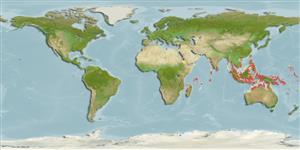>
Siluriformes (Catfishes) >
Ariidae (Sea catfishes) > Ariinae
Etymology: Arius: Greek, arios, areios = dealing with Mars, warlike, bellicose (Ref. 45335).
More on author: Valenciennes.
Environment: milieu / climate zone / depth range / distribution range
Ecología
marino; salobre demersal; no migratorio; rango de profundidad 0 - 20 m (Ref. 43081). Tropical
Distribución
Países | Áreas FAO | Ecosistemas | Ocurrencias, apariciones | Point map | Introducciones | Faunafri
Indo-West Pacific: Pakistan east to Thailand then south to the Philippines and Indonesia.
Tamaño / Peso / Age
Maturity: Lm ? range ? - ? cm
Max length : 39.5 cm NG macho / no sexado; (Ref. 43081); common length : 12.0 cm TL macho / no sexado; (Ref. 3290)
Found in marine waters, as well as estuaries and tidal rivers, at times burrowed in the soft mud of the mangroves. Feed mainly on invertebrates. Males incubate the eggs in the buccal cavity (Ref. 43081). The sharp dorsal and pectoral fin spines can inflict painful wounds. Also caught with dipnets and set bagnets. Sold mostly fresh.
Males incubate the eggs in the buccal cavity.
Jayaram, K.C., 1984. Ariidae. In W. Fischer and G. Bianchi (eds.) FAO species identification sheets for fishery purposes. Western Indian Ocean fishing area 51. Vol. 1. FAO, Rome. pag. var. (Ref. 3290)
IUCN Red List Status (Ref. 130435)
Threat to humans
Traumatogenic (Ref. 3290)
Human uses
Pesquerías: comercial
Más información
ReferenciasAcuiculturaPerfil de acuiculturaRazasGenéticaElectrophoresesheritabilidadEnfermedadesProcesamientoNutrientsMass conversion
ColaboradoresImágenesStamps, Coins Misc.SonidosCiguateraVelocidadTipo de nataciónSuperficie branquialOtolitosCerebrosVisión
Herramientas
Special reports
Download XML
Fuentes de Internet
Estimates based on models
Preferred temperature (Ref.
123201): 27.4 - 29.3, mean 28.7 °C (based on 1689 cells).
Phylogenetic diversity index (Ref.
82804): PD
50 = 0.5000 [Uniqueness, from 0.5 = low to 2.0 = high].
Bayesian length-weight: a=0.00776 (0.00492 - 0.01225), b=2.98 (2.85 - 3.11), in cm total length, based on LWR estimates for this species & (Sub)family-body (Ref.
93245).
Nivel trófico (Ref.
69278): 2.8 ±0.31 se; based on food items.
Resiliencia (Ref.
120179): Bajo, población duplicada en un tiempo mínimo de 4.5-14 años (Fec=25-35).
Fishing Vulnerability (Ref.
59153): Moderate vulnerability (35 of 100).
